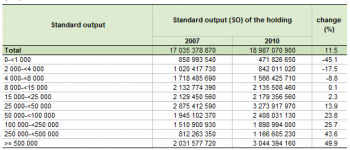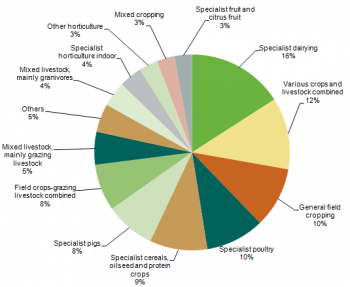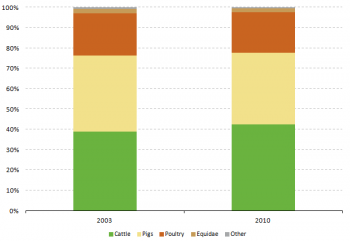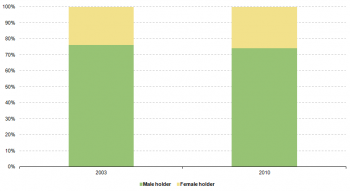Archive:Agricultural census in Poland
This article has been archived.
This article is part of a series of country-specific essays on the results of the European Union (EU) Farm structure survey (FSS) 2010. The FSS collects information on the structural characteristics of agricultural holdings (land use, livestock and labour force) and is carried out by all European Union Member States every 10 years as an Agricultural census, with two or three additional, intermediate sample surveys carried out in-between. In Poland, the Agricultural census 2010 was the first to be fully harmonised with the EU regulation, although most of the characteristics recorded in the previous one (2003) were already in line with EU requirements. The present analysis of the farm structure includes a comparison with the Agricultural census 2003. Even though the reference years of the Agricultural census in Poland were 2002 and 2010 respectively, the common designation is Agricultural census 2003 and 2010.

Source: Eurostat (ef_kvaareg) (ef_ov_kvaa) (demo_pjan) and FSS 2003 and 2010
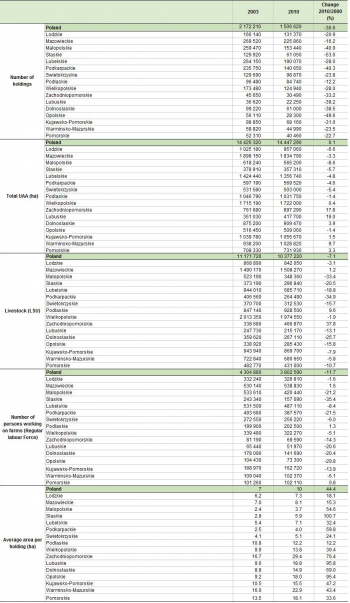
Source: Eurostat (ef_kvaareg) (ef_ov_kvaa) and FSS 2003 and 2010

Source: Eurostat (ef_kvaareg) (ef_ov_kvaa)
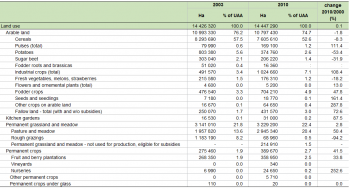
Source: Eurostat (ef_lu_ovcropaa) (ef_oluaareg)
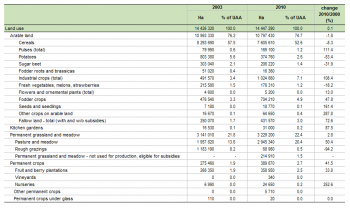
Source: Eurostat (ef_lu_ovcropaa) (ef_oluaareg)

Source: Eurostat (ef_mptenure)

Source: Source: Eurostat (ef_pmhouscatlaa)
Main statistical findings
Key indicators
Within the EU-27, Poland is among the Member States with the highest number of agricultural holdings, with more than 1.5 million according to the Agricultural census 2010 (see Table 1). In 2003 this figure was even higher at over 2 million farms, however in the intervening years roughly one out of three agricultural holdings closed down.
The utilised agricultural area (UAA) remained quite stable over the same timeframe – 14.4 million hectares corresponding to 46 % of the whole country – suggesting that small holdings were taken over by bigger ones. This tendency, widespread in the EU, is confirmed by the growth in the average size of holdings, which rose from 6.6 ha in 2003 to 9.6 ha in 2010 (+44 %).
Within the period of this analysis, the number of persons regularly working in the agricultural sector dropped by 12 %, further confirming the above mentioned trend: over 4.3 million people worked in agriculture in 2003, while in 2010 this figure dropped to about 3.8 million. Despite the decline, this represented 22 % of the active population[1]of Poland in 2010, one of the highest shares within the EU-27.
Comparing the FSS 2010 data with the FSS 2003 data, a fall (-7 %) is also observed in the population of livestock expressed in livestock units (LSU), which decreased from over 11.2 million LSU in 2003 to 10.4 million in 2010. Nevertheless, Poland remained among the Member States with the highest numbers of LSU within the EU-27.
Regional key indicators
The regional data in Table 2 shows the local characteristics of Polish agriculture. Looking at the number of holdings, three regions stood out with double-digit shares of the total number of holdings in 2010: Mazowieckie (15 %), Lubelskie (13 %) and Malopolskie (10 %). In 2003 these three regions had also recorded values higher than 10 %, together with the region of Podkarpackie. The Podkarpackie region, however, recorded one of the highest decreases (-40 %) over the period, dropping below 10 % by 2010. Although Mazowieckie, Lubelskie and Malopolskie maintained their numbers above 10 %, they also recorded considerable drops in the number of holdings.
According to FSS 2010 data, the Mazowieckie region recorded the largest share of UAA (13 %), corresponding to 1.8 million hectares; a decrease of 3 % compared with FSS 2003 data (see Table 2). In terms of UAA, the second most important region was the north-eastern territory of Wielkopolskie, with 1.7 million hectares of UAA (12 %) in 2010, the same as in 2003. In addition, another four regions registered more than one million hectares of UAA: Lubelskie (1.4 million ha), Kujawsko-Pomorskie (1.05 million ha), Podlaskie (1.03 million ha) and Warminsko-Mazurskie (1.03 million ha); the latter region recorded a noticeable increase over the 2003-2010 time period (+10 %).
In 2010, the Wielkopolskie and Mazowieckie regions were also the most significant in terms of livestock, expressed in livestock units (LSU). Wielkopolskie recorded 2 million LSU, corresponding to 19 % of the LSU of the whole country (-2 % compared with the FSS 2003) and Mazowieckie 1.5 million LSU, 14 % of the total (+1 % compared with 2003).
According to the latest structural data on agriculture, there were 538 830 persons regularly working on farms in Mazowieckie: a share of 14 % of the total number of persons working in this sector in Poland and a 1.6 % rise compared with the FSS 2003. The second highest figure was recorded in Lubelskie, where 487 110 persons were regularly employed in agriculture in 2010, corresponding to a share of 13 % (-8 % in comparison with 2003). Other notable values were recorded in Malopolskie (420 440) and Podkarpackie (387 570), both of which registered among the highest decreases (both -21 %) over the 2003-2010 timeframe.
Polish regions varied to a great extent in the average area of agricultural holdings, ranging from 3.7 hectares in Malopolskie – one of the regions with the highest share of holdings and persons regularly employed in the agricultural sector – to 29.4 hectares in Zachodniopomorskie - one of the regions lying on the opposite end of the scale for these indicators.
Agricultural holdings
An analysis of farms by size class confirms the tendency for small holdings to disappear in favour of larger ones. Over the 2003-2010 period, the number of holdings with less than 30 hectares of UAA decreased, while those with 30 or more hectares increased. As a result, as shown in Figure 1, about half of Polish farms (55 %) had less than 5 hectares of UAA in 2010, while a small number of holdings (8 %) – those with 20 or more hectares of UAA – represented 49 % of the UAA of the entire country.
In 2010, farms with 100 hectares or more of UAA covered 22 % of the UAA of the whole country, nevertheless representing only 1 % of the total number of holdings. In 2003, they represented 0.3 % of farms and covered 19 % of the Polish UAA.
See detailed data at NUTS 2 level for 2010 and 2003
Economic size of the farm
In 2010, the economic size of all Polish agricultural holdings was EUR 18 987 million (see Table 3). This value, which is calculated by adding all the standard output (SO) per hectare of crop and per head of livestock of the farms, is one of the highest recorded within the EU-27. Compared with the 2007 FSS value (17 035 million), it increased by 11.5%, due to holdings with an average monetary value of EUR 15 000 or more. In particular, the highest increase was recorded for the largest class of holdings (+50 %) – those with EUR 500 000 or more of SO. in contrast, holdings with less than EUR 1 000 recorded the sharpest fall (-45 %).
See detailed data at NUTS 2 level for 2010 and 2007
Agricultural holding by main type of farming
Analysing holdings by the main type of farming, three major types can be identified in the Agricultural census 2010. Almost one out of four Polish agricultural holdings (23 %) were specialised in general field cropping; a further 17 % were specialised in cereals, oilseed and protein crops, while 14 % produced various crops and livestock combined. All other types of production recorded shares lower 10 %, falling within the aggregate category ‘other’.
The categories appeared less significant in terms of economic size, indicating the absence of a dominant production. Four categories recorded double-digit shares, although none accounted for even one fifth of the total standard output of the country. The highest share of the total SO of Polish agricultural holdings was produced by farms specialised in dairy farming (16 %), followed by those specialised in various crops and livestock combined (12 %), while agricultural holdings specialised in general field cropping and those focusing on poultry accounted for 10 % each.
See detailed data at NUTS 2 level for 2010
Land use
The utilised agricultural area (UAA) is the total area used by the holding, regardless of the type of tenure or whether it is used as a part of common land; it consists of arable land, permanent grassland and meadow, permanent crops and kitchen gardens. In Poland, the UAA as well as the share of its main components – arable land and permanent grassland and meadows – remained fairly stable over the 2003-2010 period.
According to FSS 2010 data, arable land accounted for three quarters of the total UAA and permanent grassland and meadow 22.4 %. The two categories together accounted for over 97 % of the total UAA in Poland in 2010, compared with 98 % in 2003.
See detailed data at NUTS 2 level for 2010 and 2003
Arable land
In Poland, arable land is essentially taken up by cereals, which in 2010 occupied 70 % of arable land, corresponding to 53 % of the total UAA. As shown in Table 4, this was a decrease of 8 % compared with the FSS 2003 figure.
The only other significant category of arable land is industrial crops, which recorded over 1 million hectares in 2010, 7 % of the total UAA of Poland. Compared with 2003, the area dedicated to the cultivation of industrial crops gained importance, doubling its share in the total UAA of the country.
See detailed data at NUTS 2 level for 2010 and 2003
Permanent grassland
Between 2000 and 2010, the area of permanent grassland remained fairly stable in Poland, increasing only by about 90 000 hectares (+3 %). Nevertheless, its composition changed over the years, as land dedicated to pasture and meadow grew by 50 %, reaching about 3 million hectares compared with roughly 2 million hectares in 2003. In contrast, the area of rough grazing dropped sharply, from over one million ha in 2003 to less than 70 000 ha in 2003. In addition, more than 200 000 hectares were not used for production but were eligible for subsidies in Poland in 2010 – usually this area is used for maintaining land in good agricultural and environmental conditions (GAEC).
See detailed data at NUTS 2 level for 2010 and 2003
Livestock
Statistics on livestock use two different units of measurement: the number of head (number of animals) and livestock units (LSU), the latter allowing comparison between different types of livestock.
In 2010, more than 10 million LSU were recorded in Poland (see Table 5), one of the highest values within the EU-27. In relative terms, there were 0.38 LSU per inhabitant, the same as in 2003, as both the number of inhabitants and the population of livestock decreased over this timeframe.
Cattle are by far the most significant livestock in Poland. In 2010, they represented over 40 % of livestock or 4.4 million LSU, an increase (+1 %) compared with 2003. As shown in Table 5, pigs were the second most important type of livestock. Although their number dropped from over 4 million LSU to 3.6 million LSU over the 2010-2003 period, in 2010 they still represented 35 % of the total population of livestock in Poland. Poultry also recorded notable values: 2 million LSU, 20 % of Polish LSU in 2010.
The share of holdings with livestock in the total number of farms dropped over the years: from 67 % in 2003 to 61 % in 2010. The numbers of agricultural holdings and farms with livestock both decreased, although more rapidly for the latter. In particular, the number of farms with less than 20 LSU decreased, while holdings with 20 or more of LSU increased, suggesting that smaller farms were taken over by larger ones.
According to FSS 2010 data, Wielkopolskie was the region hosting the highest number of livestock: about 2 million LSU or 19 % of the whole population of livestock. In particular, this region accounted for 26 % of the total population of pigs.
The second most significant region for livestock was Mazowieckie, with 1.5 million LSU in 2010 or 15 % of the total. In this region cattle were most significant, with 833 250 LSU or 19 % of the total population of cattle of Poland.
See detailed data at Nuts 2 level for 2010 and 2003
Labour force
As shown in Table 6, 3.8 million persons worked on agricultural holdings in Poland. Although this was one of the highest values recorded within the EU-27, it was down by 12 % compared with 2003, when more than 4 million persons worked in the agricultural sector. If the direct labour force is taken into account, in annual work unit (AWU), Poland recorded the highest value among the then 27 EU Member States: 1.9 million AWU in 2010, -13.4 % compared with 2003.
A regional analysis shows that Mazowieckie recorded the highest number of persons employed on a regular basis: 538 830 in 2010, corresponding to 14 % of the total regular labour force in Poland. Lubelskie registered the second highest share (13 %) – 487 110 persons employed on a regular basis, followed by Malopolskie (11 %) and Podkarpackie (10 %). All together, these four regions accounted for about half of the total regular labour force in Poland in 2010.
Although the number of male sole holders decreased more than the number of female sole holders over the 2003-2010 period in Poland, three quarters of sole holders were male in 2010.
See detailed data at NUTS 2 level on holders' age and gender for 2010 and 2003
See detailed data at NUTS 2 level on type of labour force for 2010 and 2003
Management practices
Type of tenure
According to FSS 2010 data, almost three quarters of the Polish UAA (71 %) belonged to the farmers who actually worked on that land (see Table 7). Figures were even higher for the regions of Mazowieckie (86.5 %), Podlaskie (86.2 %) and Lubelskie (80.3 %).
In contrast, the area farmed by tenants amounted to 18.7 % of the total UAA. Values significantly higher than this average were recorded in Zachodniopomorskie (34.8 %), Lubuskie (31.8 %), Opolskie (30.8 %) and Dolnoslaskie (28.5 %).
The share-farmed agricultural area – which is an agricultural area utilised in partnership by the landlord and the sharecropper under a written or oral share-farming contract, or an area utilised under other modes of tenure – accounted for 10.2 % in Poland, although higher values were recorded in Lódzkie (19.5 %) and Swietokrzyskie (18.3 %).
Irrigation
As in most of the northern Member States of the EU, irrigation is also of minor importance in Poland. Indeed, the irrigable area covered only 0.6 % of the Polish UAA (85 200 ha) and the irrigated area accounted for an even smaller percentage (0.3 %) of the total UAA in 2010.
Animal housing
Among the then 27 EU Member States, Poland had one of the highest numbers of holdings with cattle. According to the Agricultural census 2010, there were 514 120 such holdings raising 5.7 million head of cattle and providing a total of 7.1 million places. Thus, in Poland the number of places exceeded the number of head of cattle in 2010, which explains why the percentage is higher than 100.
The most common type of animal housing was that where animals are in a stanchion tied stable with solid dung and manure: 4.2 million places, corresponding to 73.2 % of the total head of cattle in Poland.
A large number of places (1.7 million) was recorded under the ‘other’ (non-specified) category. Accounting for 30 % of head of cattle, these places represented the second most important category, followed by loose housing with solid dung and liquid manure: 976 370 places allocated across 71 450 holdings, accounting for 17 % of head of cattle.
Other gainful activities
According to the data of the Agricultural census 2010, there were 49 680 holdings with other gainful activities in Poland. Although these farms represent only 3.3 % of the total number of holdings, this places Poland among the EU Member States with the highest population of farms with other gainful activities – activities other than farm work, directly related to the holding and having an economic impact on the holding.
Information on other gainful activities was collected by eleven category types depending on their characteristics – one holding could register more than one activity.
In 2010, the Malopolskie and Mazowieckie regions recorded the highest number of holdings with other gainful activities: 6 560 and 5 980 holdings respectively. The most common activity other than agriculture was tourism (8 220 holdings).
See detailed data at NUTS 2 level for 2010 and 2003
Organic farming
Organic agriculture is an ecological production management system that promotes and enhances biodiversity, biological cycles, and soil biological activity. It is based on the minimal use of off-farm inputs and on management practices that restore, maintain or enhance ecological harmony.
Although the UAA under organic farming increased in Poland, it accounted for only 1.6 % of the whole UAA of the country in 2010. As shown in Table 10, it grew from 56 240 hectares in 2005 to 236 750 in 2010 – no data are available for 2003.
See detailed data at Nuts 2 level for 2010, 2007 2005
Data sources and availability
Methodological notes
The Agricultural Census 2010 was the first Agricultural census fully harmonised with the European legislation to be carried out in Poland. Nonetheless, most of the characteristics surveyed in the previous Agricultural census (2003) were already in line with the EU requirements. Following its accession to the EU, Poland conducted Farm Structure Surveys in 2005 and 2007, in accordance with the EU calendar and requirements.
Survey on agricultural production methods (SAPM)
In 2010 a unique survey was carried out together with the Agricultural census: the Survey on agricultural productions methods (SAPM). This survey collected data at regional level needed to establish agri-environmental indicators as indicated in COM final 508/2006 and to evaluate the greening of the Common agricultural policy.
Data were collected according to specifications listed in Annex V of regulation regulation 1166/2008, namely data on tillage methods, soil conservation, landscape features, animal grazing, animal housing, manure application, manure storage and treatment facilities and irrigation.
In Poland, the SAPM was conducted as a sample survey using the same threshold applied for the Agricultural census. Accordingly, the smallest holdings, which all together contributed to less than 2 % of the total UAA and less than 2 % of the total number of livestock of the country, did not enter the target population.
Reference period
Data were collected as of the 30th June 2010. Information related to a wider timeframe (i.e. the average irrigated area and support for rural development) was collected as of the three years prior to this date. Finally, data related to a period of 12 month were collected starting with the 12 months before the 30th June 2010.
Threshold for agricultural holdings
For both the FSS and the SAPM, target population included all the agricultural holdings with at least one hectare of agricultural land. Furthermore, holdings with less than one hectare of agricultural land but complying with a set of physical thresholds related to the hectares of certain types of crops or heads of cattle were also included in the target population of both the surveys.
Common land
Common land is the land that does not directly belong to any agricultural holding but on which common rights apply. It can consist of pasture, horticultural or other land. The treatment of the common land used by an agricultural holding might differ from country to country. In Poland the area of common land is non-significant; therefore, the Agricultural census 2010 as well as the previous waves of the FSS did not survey it. However, the area of common land was included in the total UAA of the country and the sections which were found to be used by agricultural holdings were recorded as leased area.
Geo-reference of the holding
The geographical location of agricultural holdings was obtained by matching the address features from the census list with the records from the statistical address database.
Economic size
From FSS 2007 onward, the standard output (SO), a new classification of the economic size of the holding, is used. The SO has replaced the standard gross margin (SGM) used before. Nonetheless, for comparability reasons, in FSS 2007 both classifications are available.
Volume of irrigation water
This characteristic was calculated for the first time in 2010 within the context of the SAPM. In Poland, the volume of irrigation water did not take into account the water used for kitchen gardens and crops under cover.
Other methodological issues
In the second half of May and the beginning of June 2010, Poland experienced one of the largest floods in its history, which particularly affected the southern regions. This caused extensive damage to permanent grassland, resulted in a loss of agricultural production, and it increased the hectares of land not intended for agricultural production. Although some of these effects could be temporary, they should be taken into consideration when analysing the Agricultural census 2010 data.
Context
European Commission Rural development policy aims to improve competitiveness in agriculture and forestry, the environment and the countryside as well as the quality of life in rural areas and to encourage the diversification of rural economies.
As agriculture has modernised and the importance of industry and services within the economy has increased, so agriculture has become much less important as a source of jobs. Consequently, increasing emphasis is placed on the role farmers can play in rural development, including forestry, biodiversity and the diversification of the rural economy, in order to create alternative jobs and provide environmental protection in rural areas.
The FSS continues to adapt in order to provide timely and relevant data to help analyse and follow these developments.
See also
- Agricultural census 2010
- All articles on Poland
- All farm structure articles by country (2007)
- Farm structure statistics
Further Eurostat information
Publications
- Agriculture, fishery and forestry statistics — Main results – 2010-11 - 2012 edition
- Farm Structure in Poland - 2007 - Statistics in focus 50/2008
- Farm Structure in Poland - 2005 - Statistics in focus 10/2006
Main tables
- Agriculture, see:
- Farm structure: historical data (1990-2007) (t_ef)
Database
- Agriculture, see:
- Farm structure (ef)
Dedicated section
Methodology / Metadata
- Farm structure (ESMS metadata file — ef_esms)
- Methodological Report – FSS 2010 Poland
- Methodological Report – FSS 2007 Poland
Source data for tables and figures (MS Excel)
Other information
- Regulation 1166/2008 of 19 November 2008 on farm structure surveys and the survey on agricultural production methods and repealing Council Regulation 571/88
- Regulation 1200/2009 of 30 November 2009 implementing Regulation 1166/2008 on farm structure surveys and the survey on agricultural production methods, as regards livestock unit coefficients and definitions of the characteristics
External links
Notes
- ↑ A value calculated over the total number of active people aged 15 to 64, as reported by the 4th quarter 2010 of the EU Labour force survey (LFS) Population by sex, age, nationality and labour status (1 000)
